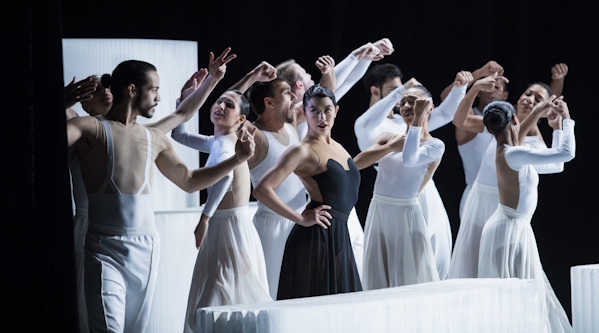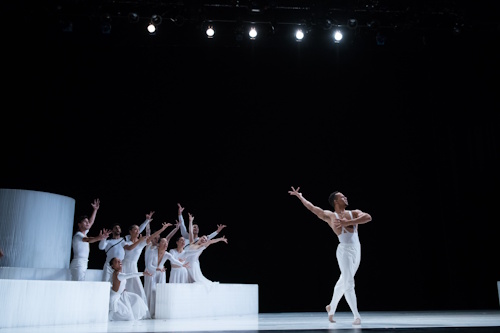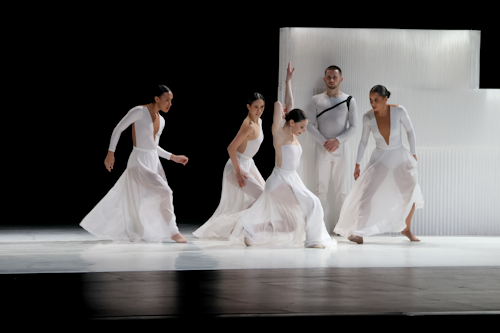Curve, Leicester
May 17, 2025
There is a lot to like about Gustavo Ramírez Sansano’s CARMEN.maquia, a contemporary, in some ways minimalist take on Prosper Mérimée’s novella and George Bizet’s opera, the latter having the 150th anniversary of its premiere this year. The story and the underlying themes of love, passion and jealousy are all there.
Made in 2012 for the now defunct Luna Negra Dance Theater in Chicago, where Ramirez Sansano was artistic director, CARMEN.maquia was subsequently adopted by Ballet Hispánico as its first full-length narrative ballet. In many ways, it’s perfect material for the company as it aims to highlight the diversity of Hispanic culture and artists, mixing tradition with innovation and a contemporary vibe. It looks terrific, and was wonderfully danced, but it does also ask for a little bit of work by the viewer at times.
Although the story is pretty much intact, the perspective from which it is viewed is altered. The Mérimée and Bizet were both very much French views of the Spanish and of their time. In his reimagined version, Valencian Ramírez Sansano brings a more authentic Spanish flavour to it, in particular taking inspiration from artist Pablo Picasso and his imagery of the bull.
Picasso also had an influence on the title. The art of bullfighting is called ‘tauromaquia.’ The artist used to say that Carmen was like the bull that nobody could domesticate or control. So, Ramírez Sansano simply replaced ‘tauro’ with ‘Carmen.’
The title character comes in a different shade too. Carmen is often visualised as beautiful, strong-willed and tempestuous; a woman not afraid to use her sexuality for power. That is all here, although Ramírez Sansano adds complexity and depth. In the ensemble scenes she’s often seen standing a little to the side, not too bothered about being part of the group or friends with the others. While Amanda del Valle certainly portrayed her as sultry and sexy, she was also cool and detached. One senses she’s weighing up what is going on, working out her next move as she plays her strategic game with both the other women and the men in her life.
In many ways, this Carmen could as easily be called Don José. It opens with him, distraught and mourning Carmen before rewinding to the start and telling how he we got to where we are. Amir J. Baldwin gave a powerfully moving performance, so much so that you actually felt sorry for him. His duets with del Valle were incredibly sensual.
Omar Rivéra’s Escamillo was delightfully vain. He’s attractive and he knows it. His leading of the ‘March of the Toreadors’ was superb, the audience clapping along very happily.
The rest of the cast were fully invested in the characters too. As they flirted, swaggered and argued, one sensed that everyone had some sort of backstory.
Everyone dealt with Ramírez Sansano’s complex choreography with ease. But it is very busy. His high-speed, high-energy approach leaves little time to catch your breath. The movement itself is unstylised, intricate and detailed. It’s also unrelenting, sometimes perhaps too much so. It also has a habit of being not entirely attuned to any lyricism in the music. But, very contemporary with occasional nods here and there to the paso doble and flamenco, you cannot deny that it’s exciting and physically charged. I would quite happily watch it again, which says much.
For once, the brief moments of vocalisation felt perfectly in place. Most notable is a dramatic but funny ‘exchange of views’ between Carmen and one of the other women, full of loud shouting and equally loud gesticulations.
The story may be colourful but Ramírez Sansano’s telling of it unfolds in a largely white setting, apparently chosen by stage designer Luis Crespo as it looks like an artist’s canvas. The set is constructed of large folds of lightweight accordion-type paper. Moved by the cast, it’s extremely adaptable and transforms easily the space. While it does hint at the outline of whitewashed buildings, it very much only vaguely suggests where the action is happening.
Very impressive are a couple of flats that drop down. Looking for all the world like Picasso paintings, one features a bull and a woman, appropriately, the other a more disturbing Guernica-like scene. It all conspires to give the work quite a modernist look, but the audience does have to ‘read’ it alongside the movement and their prior knowledge of the story.
Spanish fashion designer David Delfin picks up Crespo’s colour palette, costuming all the women wear loose-fitting, flowing and rather appealing white dresses except for Carmen, who comes not in the familiar red, but black. The men are also in largely white, with just a black stripe here and there. That Micaela is dressed like the other women, and that Don José and Escamillio are dressed similarly, makes picking them out initially quite difficult.
Musically, Ramírez Sansano uses the familiar Carmen Fantasy by Pablo de Sarasate, an arrangement of themes from Bizet’s opera, which also features in most ballet versions, bolstered by other Bizet compositions that evoke the essence of the tale. He also uses two different versions of the Habanera.
This was Ballet Hispánico’s second headline appearance at Let’s Dance International Frontiers, Leicester’s annual dance festival curated by Serendipity and its founder, CEO and artistic director Pawlett Brookes. With its conference, discussions, workshops and much more alongside performances by upcoming as well as well-known artists, it deserves to be better known. It’s certainly well worth catching. It was also the second time artistic director Eduardo Vilaro’s company have wowed. Which rather begs the question, why doesn’t someone invite them to London?




